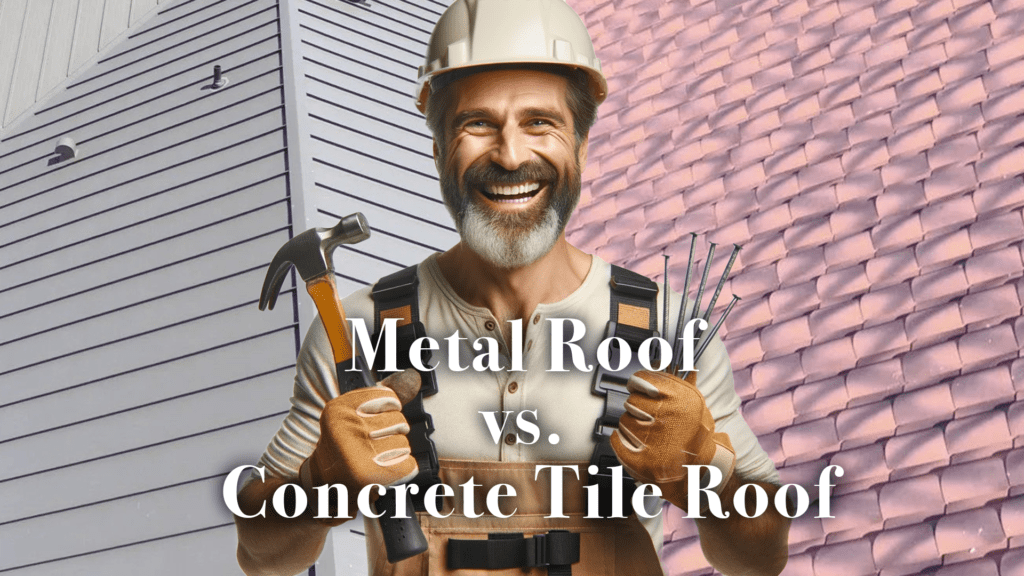Choosing the right roofing material is a significant decision for homeowners, one that affects your home’s longevity, energy efficiency, and curb appeal. In this comprehensive guide, we’ll pit metal roofing against concrete tile roofing, examining essential factors such as cost, material, colors, weight, durability, weather impact, environmental implications, and regional recommendations across the United States.
Metal vs. Concrete Roof: The Basics
Cost
- Metal Roofing: Metal roofs can be more expensive upfront but offer long-term savings due to their durability and energy efficiency.
- Concrete Tile Roofing: Concrete tiles have a lower initial cost compared to metal but may require more maintenance over time.
Material
- Metal Roofing: Typically made of steel, aluminum, or copper, metal roofs are known for their lightweight and weather-resistant properties.
- Concrete Tile Roofing: Solid concrete tiles offer a robust and durable roofing option.
Colors
- Metal Roofing: Metal roofs come in a variety of colors and styles, allowing homeowners to customize their home’s appearance.
- Concrete Tile Roofing: While they do offer color choices, concrete tiles may have a somewhat more limited selection compared to metal.
Weight
- Metal Roofing: Metal roofs are lightweight, making them suitable for a wide range of structures without requiring additional structural support.
- Concrete Tile Roofing: Concrete tiles are heavier and may require reinforcement in some cases.
Durability
- Metal Roofing: Metal roofs are exceptionally durable, with a lifespan of 40-70 years or more, depending on the material.
- Concrete Tile Roofing: High-quality concrete tiles can last 50 years or more, with excellent resistance to severe weather.
Metal Roof vs. Concrete Tile Roof: Environmental Impact
Weather
- Metal Roofing: Metal roofs are highly resistant to harsh weather conditions, including heavy rain, hail, and snow.
- Concrete Tile Roofing: Concrete tiles are sturdy and can withstand severe weather, making them a suitable choice for regions prone to hurricanes and storms.
Environmental Impact
- Metal Roofing: Metal roofs are eco-friendly due to their recyclability and energy efficiency. They reflect heat, reducing energy consumption for cooling.
- Concrete Tile Roofing: Concrete tiles are also sustainable, with a longer lifespan and low maintenance requirements, making them a greener option over time.
Metal Roof vs. Concrete Tile Roof: Regional Recommendations
- Northeast: Metal roofing provides excellent protection against snow and ice buildup.
- Southeast: Both metal and concrete tiles work, but metal’s energy-efficient properties are beneficial in the hot and humid climate.
- Midwest: Metal roofs are ideal for the region’s varying weather conditions and can handle heavy snowfall.
- West: Metal roofs excel in dry, hot climates due to their heat and fire resistance.
Metal Roof vs. Concrete Tile Roof: Facts and Statistics
- According to the Metal Roofing Alliance, metal roofing can last 40-70 years or more, significantly longer than asphalt shingles.
- Concrete tiles are known for their durability, with some types lasting over 100 years, as reported by the Concrete Tile Roofing Institute.
Metal vs. Concrete Tile Roofing in South Florida
For the hot and hurricane-prone climate of South Florida, experts typically recommend metal roofing. Metal roofs offer exceptional durability and heat reflectivity, helping to keep homes cooler in the scorching sun. They also provide excellent resistance to hurricane-force winds and flying debris. However, concrete tile roofing is also popular among Floridians, thanks to its durability and ability to withstand severe weather conditions.
A Word from the Roof Experts
In conclusion, the choice between metal roofing and concrete tile roofing depends on your priorities, budget, and regional climate. Both materials have their advantages, and it’s essential to consider your specific needs and consult with roofing professionals in your area before making a decision that best suits your home.
